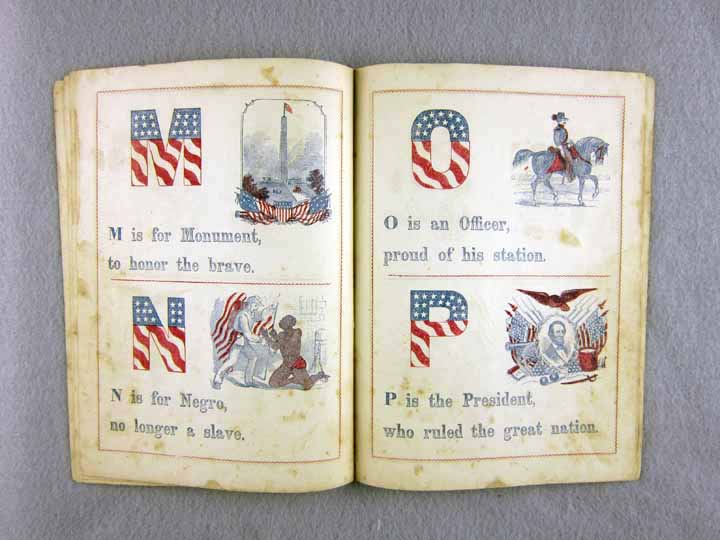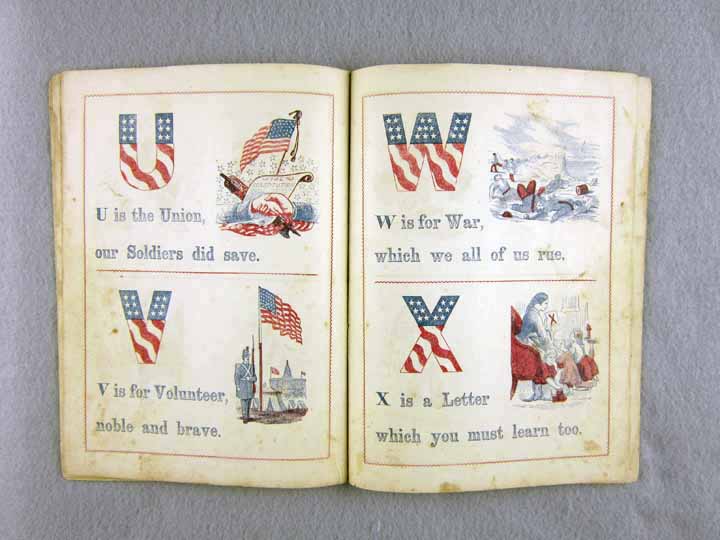

Alphabet books offer a vivid insight into the history of literacy and culture, as well as concepts of childhood. The Children's Book Collection at UCLA contains a rich array of these materials, some well-worn and much-used, some still bright and fresh. Each is a gem of print production and graphical imagery from another time and place. Though the history of alphabet books continues to the present, this exhibit focuses on the works in our collections published between 1700 and 1900, including horn books, primers, works of didacticism and seriousness, whimsy and play.
2. A Jumble ABC
3. A Little Pretty Pocket-Book
4. A New Lottery Book of Birds And Beasts
5. A Pretty Play-Thing for Children of All Denominations
8. ABC of Objects for Home And School
10. ABC with Pictures & Verses
12. Alphabet Et Instruction Pour Les Enfans
16. Dolly's ABC Book
17. Flora's ABC
18. Home ABC
22. Hornbook C. 1700
23. Large Letters for the Little Ones
24. Little ABC Book
25. Little People: An Alphabet
26. Martin's Nursery Battledoor
27. Mother Goose ABC
28. My Darling's ABC
29. Orbis Sensualium Pictus Quadrilinguis
30. People of All Nations: A Useful Toy for Girl Or Boy
31. Picture Alphabet
32. Pretty ABC
33. Railway ABC
34. Rusher's Reading Made Most Easy
38. The Alphabet of Old Friends
40. The Amusing Alphabet for Young Children Beginning To Read
42. The Child's Christian Education
45. The Easter Gift
47. The Favorite Alphabet for the Nursery
49. The Franklin Alphabet And Primer
51. The Golden ABC
55. The Moral And Entertaining Alphabet
57. The Old Testament Alphabet
59. The Picture Alphabet for Little Children
62. The Sunday ABC
63. The Union ABC
64. The Young Child's ABC, Or, First Book
65. Tom Thumb's Alphabet: Picture Baby-Books
67. Warne's Alphabet And Word Book: with Coloured Pictures
68. Wood's Royal Nursery Alphabet
Title The Union ABC



Brief description UCLA Library Catalog records a probable publication date of 1864, but book's portrayal of Abraham Lincoln suggests that text written after Lincoln's assassination in 1865. First leaf pasted down to upper wrapper; publisher's advertisement on lower wrapper. Extensive use of red, and blue inks. Illustrations. [14 pages.]
Full description Developed in celebration and support of the Union in its fight against the Confederacy in the American Civil War, The Union A B C is saturated in military and patriotic symbolism, seen in its color scheme of red, white, and blue; its intensive use of images of soldiers, flags, stars and stripes, weapons, and battle scenes; and its inclusion of visual and verbal references to the end of slavery and to the rule of law and the Constitution. Its typography is particularly striking for its incorporation of the flag into the letters, which are composed of white stars on a blue background on top and red and white wavy stripes on the bottom. Though larger than the typical chapbook (this book is approximately 15 cm by 22 cm) and surely more expensive to produce and purchase considering its use of color, this book shares some features with that form, including its brevity (14 pages) and its hand-sewn binding. As seen in the advertisements on its back cover, the book's publisher, Degen, Estes, was an active producer of books and other materials for children, such as Toy Books, a Chicken Little series, and Games and Union Reward Cards; the latter feature pro–Union, patriotic themes.
Literacy As it guides its readers towards a literacy that connects words with letters, The Union A B C also teaches them to understand the world in terms of an ideal: America as fought for by the Union forces, a land of respect for the rule of law and for freedom. The book develops several types of literacy, including respect for military service and bravery, as seen in its depictions of soldiers enduring the terror of bloody battle and aiding slaves on the one hand while presenting a lone traitor hanging on the other. It also teaches its readers to recognize symbols of the Nation, such as eagles, flags, uniforms, law, and Constitution. In this, the book uses both images and text in a way that blurs their boundaries: Presented in the patriotic palette of red, white, and blue in typography designed in stars and stripes, the letters are themselves testaments to the mythical ideal the book seeks to convey: these letters suggest boldness; abundant energy (the wavy stripes suggest a world in motion); and pride in the national project, as the colors and symbols recur throughout the words and pictures. The clean lines of the sans serif font, new in its day, suggests unimpeded forward motion (an image not unlike that sought by advertisers using this style in decades since, up through the present), while the use of text to highlight the importance of a secular, rather than a Biblical, understanding of the "Word"—in the repeated use of the nouns "Constitution" and "law" in portions of the page otherwise devoted to illustrations—also draws attention to the importance of literacy to attach foundational, history–making meanings to letters.
Childhood The Union A B C contains only two images featuring children, one of which does double duty, serving to represent both Little Ben, the Drummer Boy, and Youth (“who a soldier would go”). The other image occurs to illustrate a lesson about the letter X, and features three children gathered around their seated mother's skirts, absorbing her instruction by listening eagerly and by playing with blocks imprinted with the letter. Other than these direct visual references to children, this book presents a world dominated by military imagery and patriotic themes (the liberal use of red, white, and blue, as well as stars, stripes, and flags) that prompt support and appreciation for the Union soldiers and their mission in the Civil War. The book illustrates these perspectives without fully sanitizing the horrors of war, using red to paint blood on images of dying soldiers. The notion of childhood depicted in the book is one in which children face war as a fact of life and accept it as a patriotic duty, an obligation that the imagery and text celebrate with its colors. It depicts soldiers fighting, helping, and sacrificing (for example, by eating hardtack); the few occurrences of text name the Constitution and the rule of law as grounding the nation.
Iconography The Union A B C's cover is a study in an iconography of patriotic purpose, strength, celebration, achievement, bravery, and might. Symbols repeat and underscore each other: for example, the flag appears not only as part of the central image, as a soldier hoists it while charging into battle; it also appears as a resolution to this action and an assertion, as a soldier plants it into the ground. Beyond this, its colors infuse the very text, whose letters consist of bold stars and stripes, each character announcing the proud and bold power of the Union. While the image's border suggests beauty and celebration and the multiple flags' wavy stripes suggest the dynamic motion of a country in formation, the steadfastness depicted in the human images echoes the mettle of their weaponry—it is only through unyielding, purposeful battle that the Union will emerge victorious from this devastating Civil War. That this purpose is deadly serious is underscored by the people's gazes as seen on the book's cover: On the right, soldiers focus forward, immune to all but their mission ahead; on the left, a soldier raises his arm in affirmation as he eyes his compatriot planting the flag. The most prominent person featured, the soldier in the cover's center, focuses on—and challenges—us, the reader/learners: His eyes meet ours, calling on us to absorb the image's messages. In its interior pages, the book's images and text show us many cultural symbols: woman as ideal of American freedom, pointing outward to suggest movement forward; the captain, with his flag, as the uprightness of the Union's mission; the boy not as carefree child, but as part of the patriotic corpus, contributing what he can by serving as a drummer to shape the military music; the tools and ways of the soldier as an important facets of life, as seen in the image of the knapsack. Color is essential in the book's imagery: even as the red, white, and blue scheme consistently displays the patriotic messages, the use of red for blood, as seen in the battle scene for the letter "B," conveys the brutality of war--this use of color leaps out from its more orderly capturing in the letters and the lines of the other illustrations. Along with color, the book's use of geometry—as well as its absence—also conveys meaning: while flags point upward, lances are thrust at angles; arms are raised up and out; and soldiers stand erect, braced and steady. Meanwhile, on one spread, a freed slave kneels—one might say, still subservient—at the feet of a Union soldier, while on another, "Contrabands" dance, their figures curved and dynamic in motion, outlines that suggest not only freedom, but also unruliness. This latter quality, the book's iconography suggests, may require shaping—being brought into line—by what are depicted as the "civilizing" forces that the Alphabet exemplifies.
Production The Union A B C is rare: according to WorldCat, aside from UCLA, only six other libraries own a copy of this edition: The Huntington Library, Yale; University of Florida; the New York Historical Society Library; Brown, and Virginia Tech. Three libraries own copies for which they have not provided a publication date; two own copies for which they have listed the publication date as being possibly between 1865 and 1866; and one library lists its edition with a publication date in the 1860s. These dates are important, falling as they do during the American Civil War and the period of Abraham Lincoln's assassination (April 14, 1865). While according to at least one source, this book was published in 1864 (a date also listed for most versions named in WorldCat), the book's text, and especially its imagery, suggest that it was published after the president had been killed: Lincoln's image appears as a portrait, as if overseeing the Union's accomplishments from afar, implying that he has died.
Creator
Publisher Degen, Estes & Co.
Publication place 362 Pearl-Street, Boston
Date 1864
UCLA Call Number CBC * PE1119.A1 U55 1864
Repository UCLA Charles E. Young Research Library, Dept. of Special Collections
Dimensions 22 cm
Additional Information Inscription: John Charles Morton Blackmer by his father. 1890. Written in ink, front cover, top.